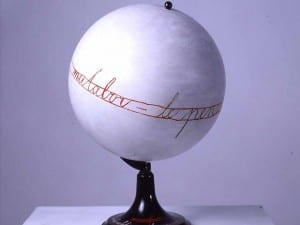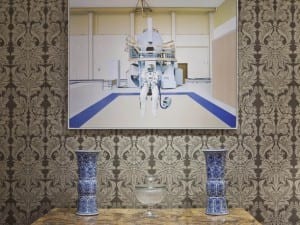The ninth Edinburgh Art Festival launches today with major exhibitions by leading international artists. Edinburgh Art Festival is the UK’s largest annual festival dedicated to visual art. Taking place in over 30 of the city’s museums, non-for-profit and commercial galleries, EAF features over 50 exhibitions, from the biggest blockbuster names in Edinburgh’s leading visual arts spaces to the most exciting early-career artists, pop up shows and events across the city.
If you are in Edinburgh at this time of year, you are probably already overwhelmed with “must-see” shows and exhibitions. In the spirit of squeezing as much into one month as possible, here are our highlights from this year’s festival:
1. Dieter Roth: Diaries
Fruitmarket Gallery, 45 Market Street, Edinburgh EH1 1DF
www.fruitmarket.co.uk
One of late 20th century art’s major figures, Dieter Roth (1930 – 1998) was an artist of astonishing breadth and diversity, producing books, graphics, drawings, paintings, sculptures, assemblages and installation works involving sound recordings and video. For Roth, art and life readily flowed into one another, and much of the material for his artistic output came from his everyday life.
This exhibition focuses on the theme of the diary in Roth’s work. Roth kept a diary throughout his life, and saw all art-making as a form of diary keeping. His diaries were a space to record appointments, addresses, lists and deadlines but also ideas, drawings, photographs and poems. They teem with graphic exuberance, and proved a rich source for his work. In this exhibition, Roth’s diaries are on display to the public for the first time, as well as the hand-produced, photocopied ‘copybooks’ he made from them to sell to favoured collectors and friends.
Many of Roth’s major works can be understood as kinds of diaries. In the mid 1970s, he attempted to record a year of his life through rubbish, collecting and preserving all rubbish less than one or two sixteenths of an inch thick. The resulting work, Flat Waste, celebrates and subverts the ordering principle of the diary. Solo Scenes, a vast video diary, records the last year of Roth’s life on 135 video monitors.
2. Rachel Mayeri: Primate Cinema: Apes as Family
Edinburgh College of Art, 74 Lauriston Place, EH3 9DF
www.eca.ac.uk
Primate Cinema: Apes as Family is a dual screen video installation that presents a drama written for chimpanzees and performed by human actors juxtaposed with the reactions of an audience of chimps.
Watching the chimpanzees watching themselves portrayed in film, we’re moved to consider how much of our character and behavioural traits we share with our closest primate relatives. Mayeri’s intriguing and amusing story-and-response structure of the installation contains dark undercurrents in its contemplation of the lives of the chimpanzees.
Researched and partly filmed at Edinburgh Zoo, the Los Angeles based artist Rachel Mayeri collaborated with comparative psychologist Dr Sarah-Jane Vick to develop the work. Together they tested different styles and genres of film to understand patterns of cognition and communication amongst research primates.
3. Festival Promenade
Various Venues
EAF 2012 includes the Festival’s most ambitious commissioning programme to date, a “Festival Promenade” featuring artists and collectives which will emerge around Edinburgh’s historic monuments and public spaces, bringing visual art to the heart of the city’s Festival experience. Commissioned artists include Scottish-born Turner Prize winner Susan Philipsz, who has created a new work entitled Timeline, retracing an historic, but now invisible line through Edinburgh’s city centre. Inspired by Edinburgh’s famous One O’clock Gun and the city’s ancient maritime history, Timeline explores themes of sound and distance, plotting a series of short sound installations in some of the city’s most atmospheric sites, from The Nelson Monument on Calton Hill, to Old Calton Cemetery, Waverley Bridge and The National Gallery of Scotland on The Mound.
Internationally-celebrated artist Callum Innes has created his first intervention with light. A co-commission by Ingleby Gallery and EAF, the work transforms Edinburgh’s historic Regent Bridge – a major thoroughfare between the Old and New towns – from a dark tunnel to a celebratory arch. “Festival Promenade” also features Glasgow-based artist Andrew Miller’s Festival pavilion, The Waiting Place, in St Andrew Square. A playful summerhouse constructed entirely from timber and nestled in and around the square’s numerous trees The Waiting Place is the Festival’s central hub throughout August, playing host to a full programme of events including artists’ talks as well as The Ellie & Oliver Show, which will be broadcast from the pavilion every Friday. Rose Street will play host to a film programme, as well as a new exhibition of work by recent Edinburgh College of Art graduate and Honda Dream Factory participant Kevin Harman, who has come to critical attention for his simple interventions with skips: transforming heaps of rubble and debris into beautiful sculptural assemblages.
4. Ian Hamilton Finlay: Twilight Remembers
Ingleby Gallery, 15 Calton Road, Edinburgh, EH8 8DL
www.inglebygallery.com
The exhibition begins with a re-discovered moment of genius by the late Ian Hamilton Finlay. Carrier Strike (1977) is a classic Finlayesque clash of the heroic and the domestic: in this case an epic air/sea battle played out on the surface of an ironing board. Photographed by Carl Heideken and set to music by John Purser, the ironing board becomes an aircraft carrier, surrounded by destroyer irons, and small model planes amongst cotton wool clouds. Like all Finlay’s best work, the ideas are layered and delivered with gentle humour.
Three boulders, carved with the names of Japanese war planes become stepping stones from the war- zone of Carrier Strike to the garden works that dominate the rest of the exhibition, recalling the most familiar of Finlay’s ‘detached sentences on gardening’ that Certain gardens are described as retreats when they are really attacks.
The garden, gardening, and specifically man’s relationship with and against nature, provided the backdrop for Finlay’s life’s work. At the heart of this exhibition are a group of garden works that turn the gallery into a colony of Little Sparta, the classical garden and self-styled ‘Raspberry Republic’ that Finlay built over 40 years and which cradled so many of his artistic and philosophical beliefs. Carved stones, garden stiles, brick paths and bronze spades are marshalled into the service of Finlay’s ideas, interwoven with reference to the classical world, the French revolution, the sea and the world at war.
5. Tim Rollins & K.O.S.: The Black Spot
Talbot Rice Gallery, The University of Edinburgh, Old College, South Bridge, Edinburgh, EH8 9Y
www.ed.ac.uk
Showing for the first time in Scotland, Tim Rollins and K.O.S. present an exhibition including new work and a series of Art and Knowledge Workshops. Coming to Edinburgh direct from the first Frieze New York, the collective’s literary and music inspired work continues to make waves within contemporary art. Surveying their work at Frieze, Simon Schama commented that, “combining instruction in reading and writing with collaborative art-making has resulted in some work of spectacular radiance as well as social energy”.
The exhibition title, The Black Spot, is taken from Stevenson’s Treasure Island, the classic adventure story that has inspired a new work for Talbot Rice. The Black Spot is a summons to audiences to reinvigorate a belief in the power of art to change lives.
Edinburgh Art Festival, Various Locations, 2 August until 2 September. www.edinburghartfestival.com
Credits:
1. Dieter Roth, Solo Scenes (1991-1998)
Photo: Heini Schneebeli
2. Photo courtesy: Rachel Mayeri
3. W&AK Johnston Time Gun Map (1879)
Reproduced by permission of the Trustees of the National Library of Scotland
4. Ian Hamilton Finlay Carrier Strike! (1967)
Photographs by Carl Heideken and music by John Purser
5. Amerika Infinity (after Franz Kafka) (1987-88)
Courtesy Galerie Eva Presenhuber, Zurich © the artist




